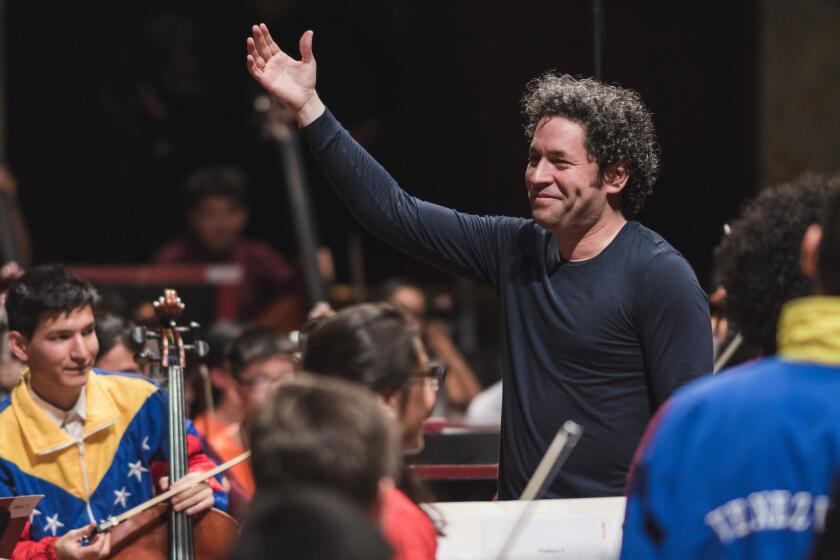ART REVIEW : ‘Ballerina Clown’--The Court Jester of Venice
- Share via
Like lightning that suddenly explodes from the quiet gathering of invisible, charged particles in the atmosphere, Jonathan Borofsky’s best work manages to pull you up short by igniting a sudden crack! of recognition. A spectator, wide-eyed and delirious, is left momentarily reeling.
Borofsky’s great “Ballerina Clown,” a monumental sculpture unveiled last week at the conspicuous corner of Main Street and Rose Avenue in Venice, is just such an extraordinary concatenation of forms. Thirty feet tall, mechanized, vividly painted and perched on a soap box high atop an architectural pedestal, the gently kicking dancer wears oversize gloves and the bulb-nosed mask of a sentimental circus clown.
A figure rather like an eccentric, streetside orator magically elevated to civic symbol, “Ballerina Clown” stands as a poignant, sharply observed visual essay on everybody’s worst nightmare: the gentle soul magnanimously determined to add at least a slender grace note to the world, yet pitilessly being taken for a laughingstock.
A certain irony marks this ego-wrenching subject. For there are those who, caught unawares by Borofsky’s startling sculpture, harbor a sneaking suspicion that it might be they who are being made the fool. Stand at Rose and Main for any length of time and you’re bound to see and hear the full range of possible opinion about the piece, from shrieks of stunned delight to grumpy grimaces.
It’s understandable. Yes, the sculpture could claim a heady modern ancestry, from Watteau’s Pierrot and Degas’ dancers to the circus performers of Picasso and Seurat. In my experience, however, nothing, anywhere, is quite like Borofsky’s dancing giant.
“Ballerina Clown” does connect in the memory with objects familiar from the daily landscape, most notably the cartoon colossuses peddling hamburgers, automobile tires, exterminators and such all along roadside America. Astutely sizing up the sculpture’s highly public site, the artist has chosen to speak with a common vocabulary of public forms.
Perhaps because we’re used to dismissing those commercial signs as junky ephemera, at best, or as intrusive eyesores, at worst, there is an initial dazed resistance to seeing a related motif inhabiting the vaunted precinct of public art. That is where we have come to expect something decorative and pretentious, not to mention airlessly innocuous.
Still, I think there is another reason Borofsky’s sculpture might draw some fire amid enchantment. Like anything foreign or strange, “Ballerina Clown” is a convenient magnet for whatever unfocused feelings of ill-will might linger toward Venice Renaissance, the huge real estate development to which it is attached, and for which it was commissioned. Succinctly described in publicity materials as “an upscale, mixed-use project” featuring 1.6 acres of “retail shops, restaurants and deluxe upscale condominiums with ocean views,” Venice Renaissance was built by Harlan Lee & Associates and the Anden Group, and designed by architect Johannes Van Tilburg.
As a project, it’s a typically banal, pastel behemoth by the beach. Corinthian columns not withstanding, the “rebirth” lifelessly proposed by the block-long Venice Renaissance is one in which a faded neighborhood gets relentlessly gentrified--surprise!--thus retelling a single-minded tale of real estate that is just about synonymous with the modern story of Los Angeles, of California, of the United States. The sculpture is the single best thing about the place.
Jonathan Borofsky frequently adapts past motifs in his work to new situations, wholly remaking them in the process, and that is what he has done here. “Ballerina Clown” began life in 1982-83 as a gallery-scale sculpture that woozily sings a recorded rendition of the self-absorbed Frank Sinatra hit, “My Way.” The oddly affecting piece is among the artist’s best.
Subsequently, the tutu-and-toe-shoe-clad dancer turned up as a nearly lifesize graphic figure, her left hand holding a kite-string from which a plastic ring bobbed, in a series of hand-colored lithographs. They may be the world’s first animated prints.
The Venice figure, in keeping with its monumental new scale and the demands of its bulky site, has been made less spindly than in these earlier incarnations. Gone are the ballerina’s lace tights, the kite string and plastic ring. It is wired for sound, but reportedly won’t sing except on unnamed special occasions. (I can’t wait!) Balancing en pointe and perpetually kicking her mechanical right leg, she holds together left thumb and forefinger in a gesture somewhere between a Buddhist pose of meditation and the all-American signal for “OK.”
Remarkably, Borofsky’s sculpture draws life from, and gives it back to, its inimical context. Given the public and commercial setting, a peculiar spin attends its deft allusion to roadside signage. Real estate development is typically hawked with beneficent, lofty claims, which invariably seem to result in a built environment that’s proud to wear a grotesque public face. And that is a pretty good description of a poised ballerina wearing the clownish mask of the fool.
Of course, the rosy rhetoric of civic uplift also fuels the claims commonly made for public art, claims that have left the landscape littered with dross. It’s rare indeed for public art to critically address its own situation, but that’s what “Ballerina Clown” triumphantly does. Venerable is the legacy of the tragi-comic court jester, whose license it is to publicly ridicule the very institutions that support him.
At Venice Renaissance a second commissioned sculpture is more typical of the bland mediocrity commonly churned out to match the fulsome rhetoric. Guy Dill’s “The Harmic Arch” is a 75-foot span of welded, skeletal, geometric shapes that vaults over the Navy Street entrance to the parking garage. (“Harmic” is reportedly a Sumatran word meaning “coming from a humble/heroic element.”) Garage entrances tend to be ugly, if plainly necessary, and this one is no exception. Appended to the architectural forms of the building, the Tinkertoy shapes of the sculpture create luxury camouflage for the unsightly driveway--chiefly for the benefit of residents in the half-dozen “deluxe upscale condominiums,” whose ocean-view balconies loom out over the concrete abyss.
By rather stark contrast, Borofsky’s streetside sculpture admits of both deeply human desire and equally human failing. A communal gesture of remarkable generosity and goodwill, it’s a momentous work of public art.
More to Read
The biggest entertainment stories
Get our big stories about Hollywood, film, television, music, arts, culture and more right in your inbox as soon as they publish.
You may occasionally receive promotional content from the Los Angeles Times.











